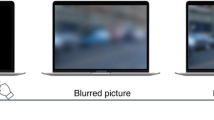Abstract
This paper describes the design and comparative evaluation of three methods that aid the acquisition of small targets. The first method, called ‘bubble targets’, increases the effective width of the target as the pointer approaches. The second method uses a form of’ stickiness’ to restrict movement as the pointer passes over an object. In the third method, called ‘goal-crossing’, the user simultaneously presses two mouse buttons before passing the pointer over the item. Goal-crossing overcomes the need for the user to decelerate the mouse when acquiring the target. Two evaluations were conducted, with the first (n = 37) based on the acquisition of abstract targets for Fitts’ Law modelling, and the second based on an ecologically oriented window resizing task (n = 11). Both showed that goal-crossing allowed the fastest target acquisition, but that it produced high error rates and was unpopular with participants. The ‘bubble’ and’ sticky’ techniques also allowed faster target acquisition than the traditional approach, and users were enthusiastic about them. Fitts’ Law accurately modelled all techniques. Implications of the results for general user interface design are briefly discussed.
Access this chapter
Tax calculation will be finalised at checkout
Purchases are for personal use only
Preview
Unable to display preview. Download preview PDF.
Similar content being viewed by others
References
Accot, J. & Zhai, S. [1997], Beyond Fitts’ Law: Models for Trajectory-based HCI Tasks, in S. Pemberton (ed.), Proceedings of the CHI’97 Conference on Human Factors in Computing Systems, ACM Press, pp.295-302.
Accot, J. & Zhai, S. [2002], More than Dotting the i’s — Foundations for Crossing-based Interfaces, in D. Wixon (ed.), Proceedings of CHI’02 Conference on Human Factors in Computing Systems: Changing our World, Changing Ourselves, CHI Letters 4(1), ACM Press, pp.73–80.
Brewster, S. A., Wright, P. C. & Edwards, A. [1994], The Design and Evaluation of an Auditory-enhanced Scrollbar, in B. Adelson, S. Dumais & J. Olson (eds.), Proceedings of the CHI’94 Conference on Human Factors in Computing Systems: Celebrating Interdependence, ACM Press, pp. 173-9.
Fitts, P. M. [1954], The Information Capacity of the Human Motor System in Controlling Amplitude of Movement, British Journal of Educational Psychology 47(6), 381–91.
Fraser, J. & Gutwin, C. [2000], The Effects of Feedback on Targeting Performance in Visually Stressed Conditions, in S. Fels & P. Poulin (eds.), Proceedings of Graphics Interface Conference, Morgan-Kaufmann, pp. 19-26.
Gaylin, K. [1986], How are Windows Used? Some Notes on Creating an Empirically-Based Windowing Benchmark Task, in M. Mantei & P. Orbeton (eds.), Proceedings of the CHI’86 Conference on Human Factors in Computing Systems, ACM Press, pp.96-100.
Gutwin, C. [2002], Improving Focus Targeting in Interactive Fisheye Views, in D. Wixon (ed.), Proceedings of CHI’02 Conference on Human Factors in Computing Systems: Changing our World, Changing Ourselves, CHI Letters 4(1), ACM Press, pp.267–74.
Langdon, P., Keates, S., Clarkson, P. & Robinson, P. [2000], Using Haptic Feedback to Enhance Computer Interaction for Motion-Impaired Users, in P. Sharkey, A. Cesarani, L. Pugnetti & A. Rizzo (eds.), Proceedings of 3rd International Conference on Disability, Virtual Reality and Associated Technologies (ICDVRAT 2000), Reading University, pp.25-32.
MacKenzie, I. [1991], Fitts’ Law as a Performance Model in Human-Computer Interaction, PhD thesis, University of Toronto.
MacKenzie, I. A. [1992], Movement Time Prediction in Human-Computer Interfaces, in N. Jaffe (ed.), Proceedings of Graphics Interface’ 92, Canadian Information Processing Society, pp. 140-50.
MacKenzie, I. & Buxton, W. [1992], Extending Fitts’ Law to Two-Dimensional Tasks, in P. Bauersfeld, J. Bennett & G. Lynch (eds.), Proceedings of the CHI’92 Conference on Human Factors in Computing Systems, ACM Press, pp.219-26.
MacKenzie, I. & Riddersma, S. [1994], Effects of Output Display and Control-Display Gain on Human Performance in Interactive Systems, Behaviour & Information Technology 13(5), 328–37.
McGuffin, M. & Balakrishnan, R. [2002], Acquisition of Expanding Targets, in D. Wixon (ed.), Proceedings of CHI’02 Conference on Human Factors in Computing Systems: Changing our World, Changing Ourselves, CHI Letters 4(1), ACM Press, pp.57–64.
Oakley, I., Brewster, S. A. & Gray, P. D. [2001], Solving Multi-target Haptic Problems in Menu Interaction, in M. M. Tremaine (ed.), CHI’01 Extended Abstracts of the Conference on Human Factors in Computing Systems, ACM Press, pp.357-8.
Worden, A., Walker, N., Bharat, K. & Hudson, S. [1997], Making Computers Easier for Older Adults to Use: Area Cursors and Sticky Icons, in S. Pemberton (ed.), Proceedings of the CHI’97 Conference on Human Factors in Computing Systems, ACM Press, pp.266-71.
Author information
Authors and Affiliations
Editor information
Editors and Affiliations
Rights and permissions
Copyright information
© 2004 Springer-Verlag London
About this paper
Cite this paper
Cockburn, A., Firth, A. (2004). Improving the Acquisition of Small Targets. In: O’Neill, E., Palanque, P., Johnson, P. (eds) People and Computers XVII — Designing for Society. Springer, London. https://doi.org/10.1007/978-1-4471-3754-2_11
Download citation
DOI: https://doi.org/10.1007/978-1-4471-3754-2_11
Publisher Name: Springer, London
Print ISBN: 978-1-85233-766-7
Online ISBN: 978-1-4471-3754-2
eBook Packages: Springer Book Archive




